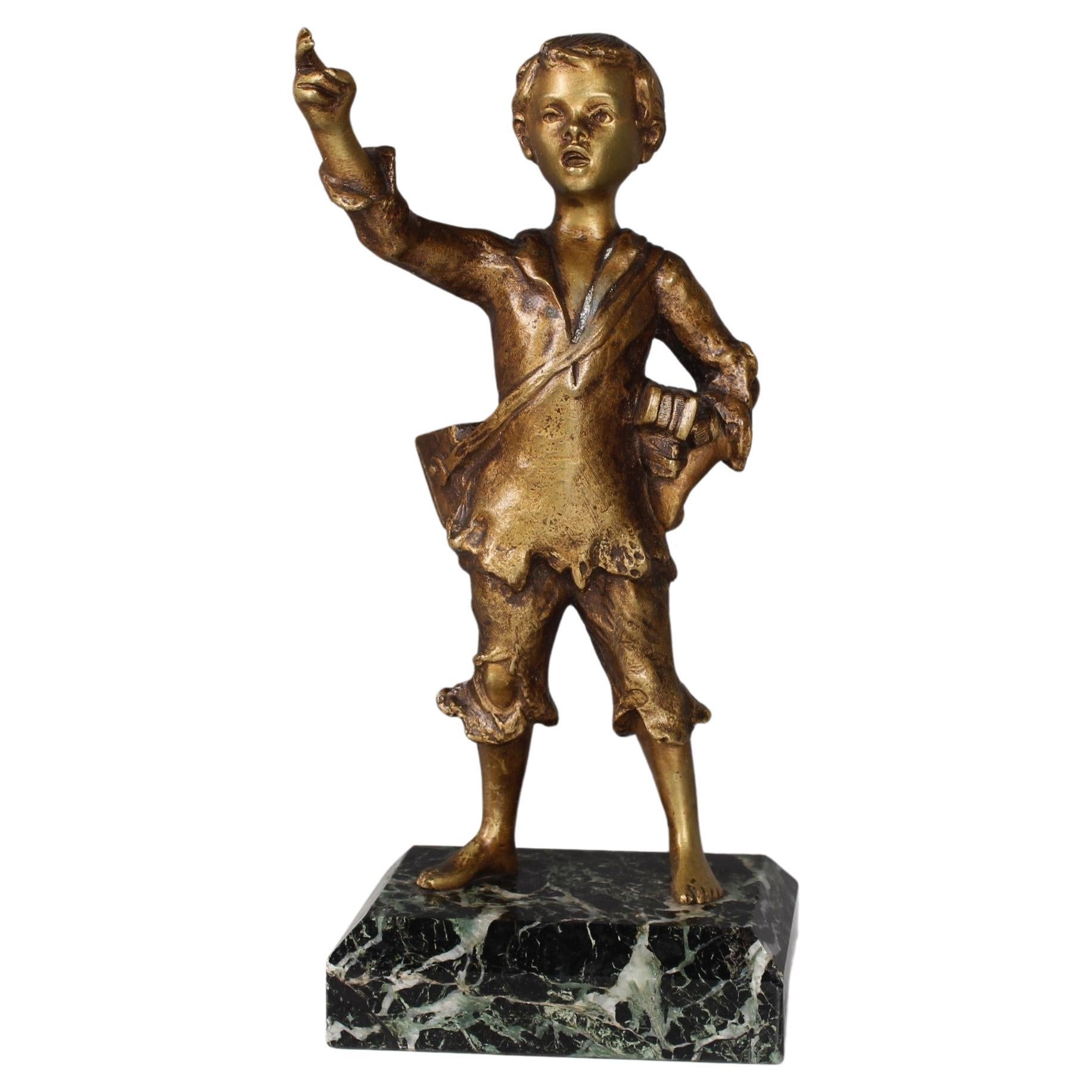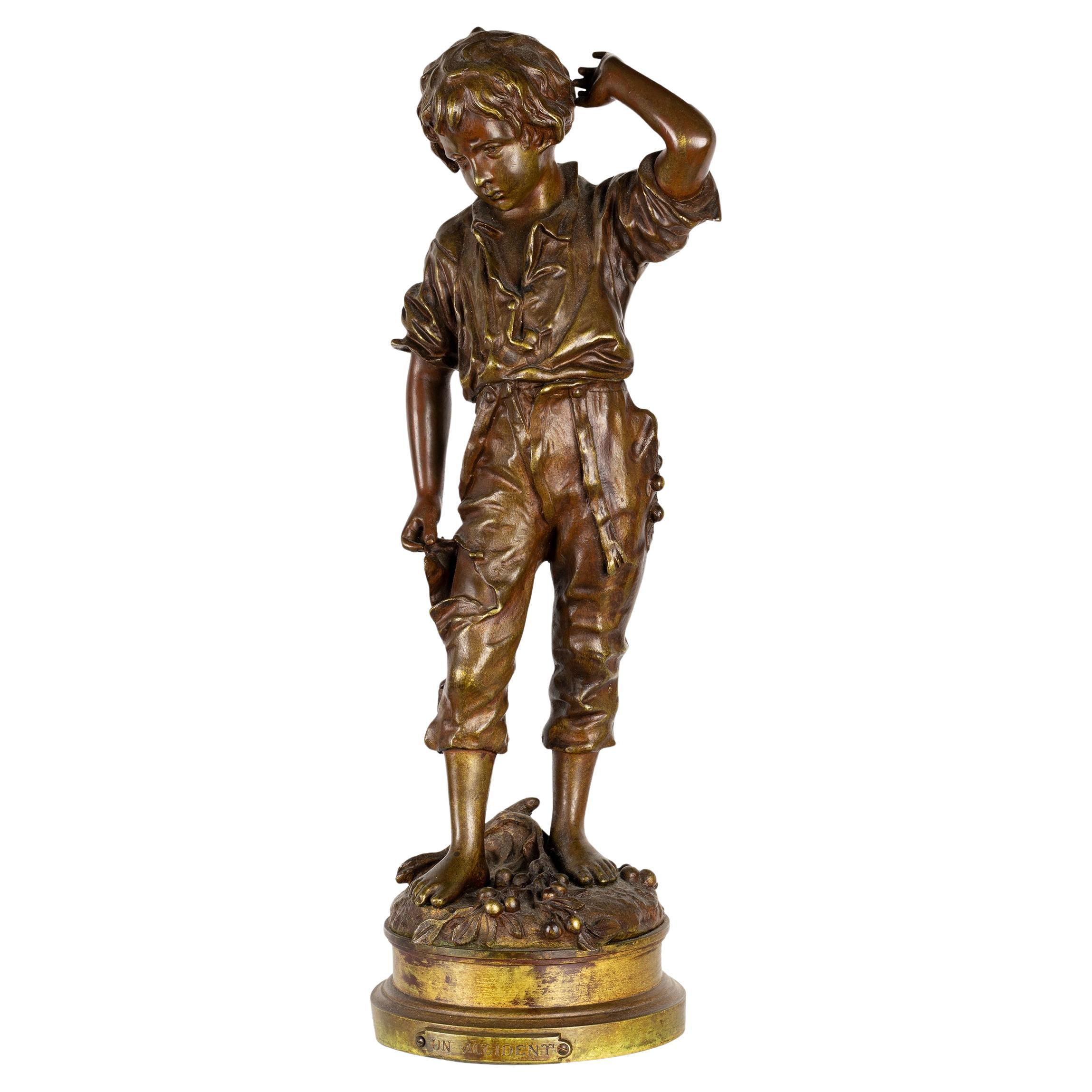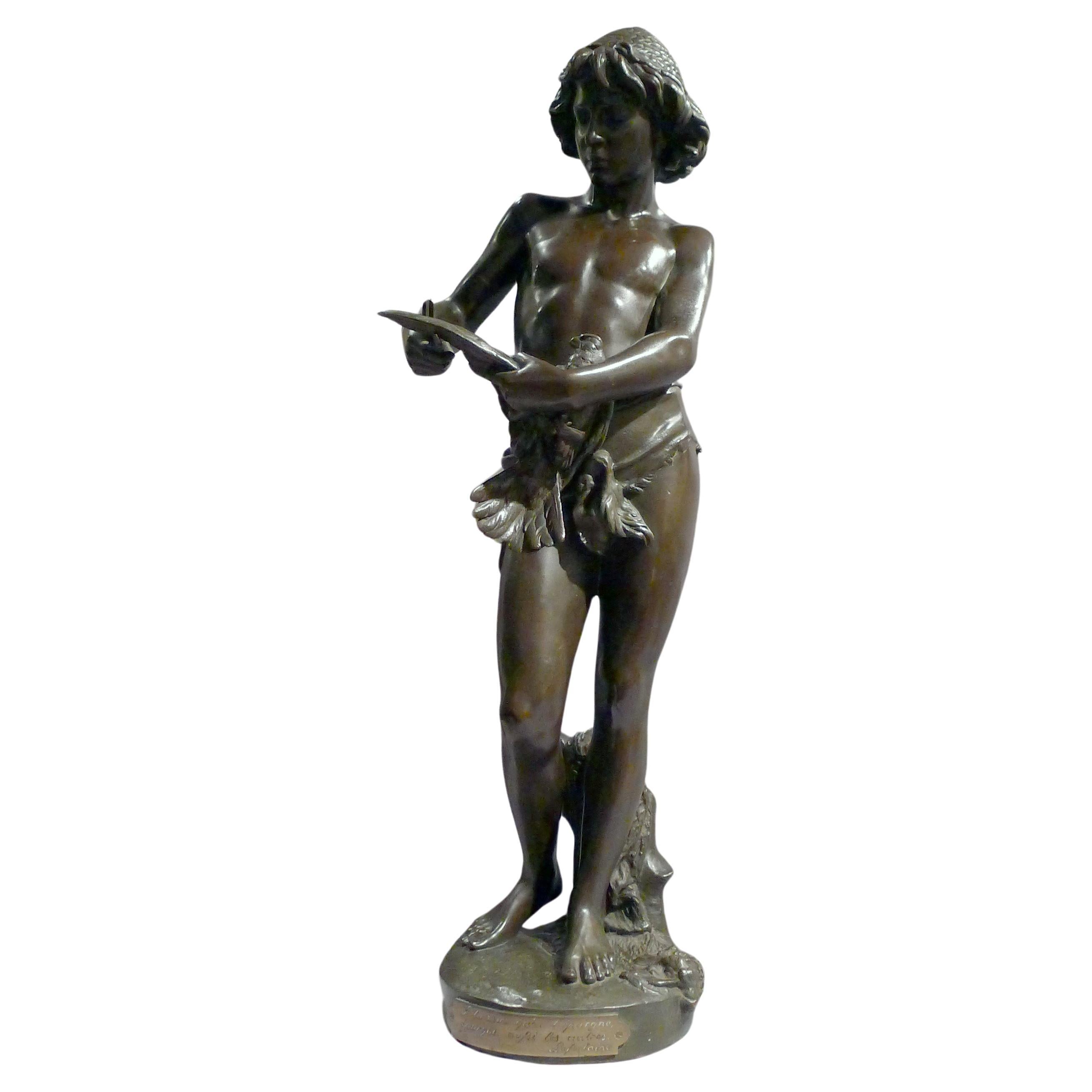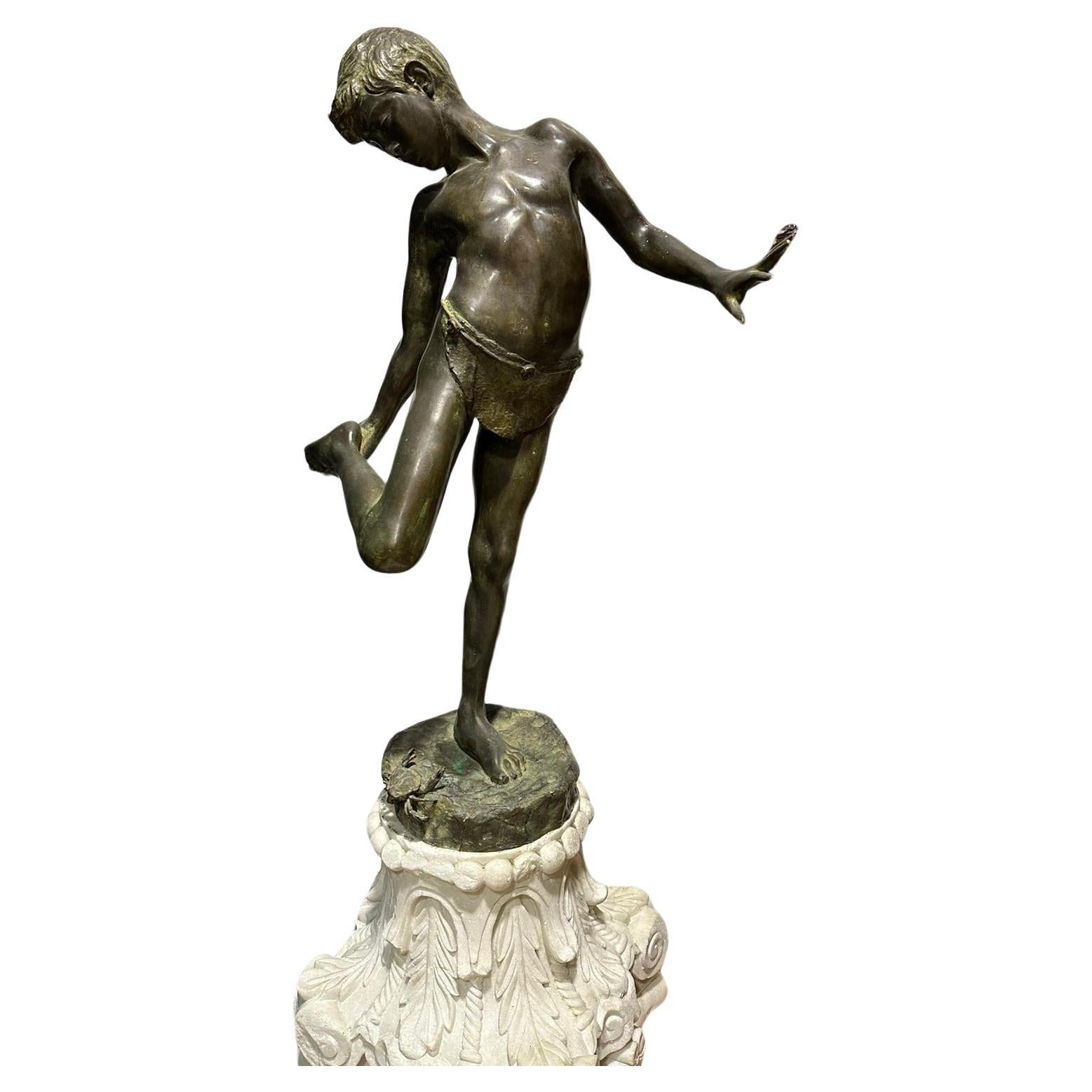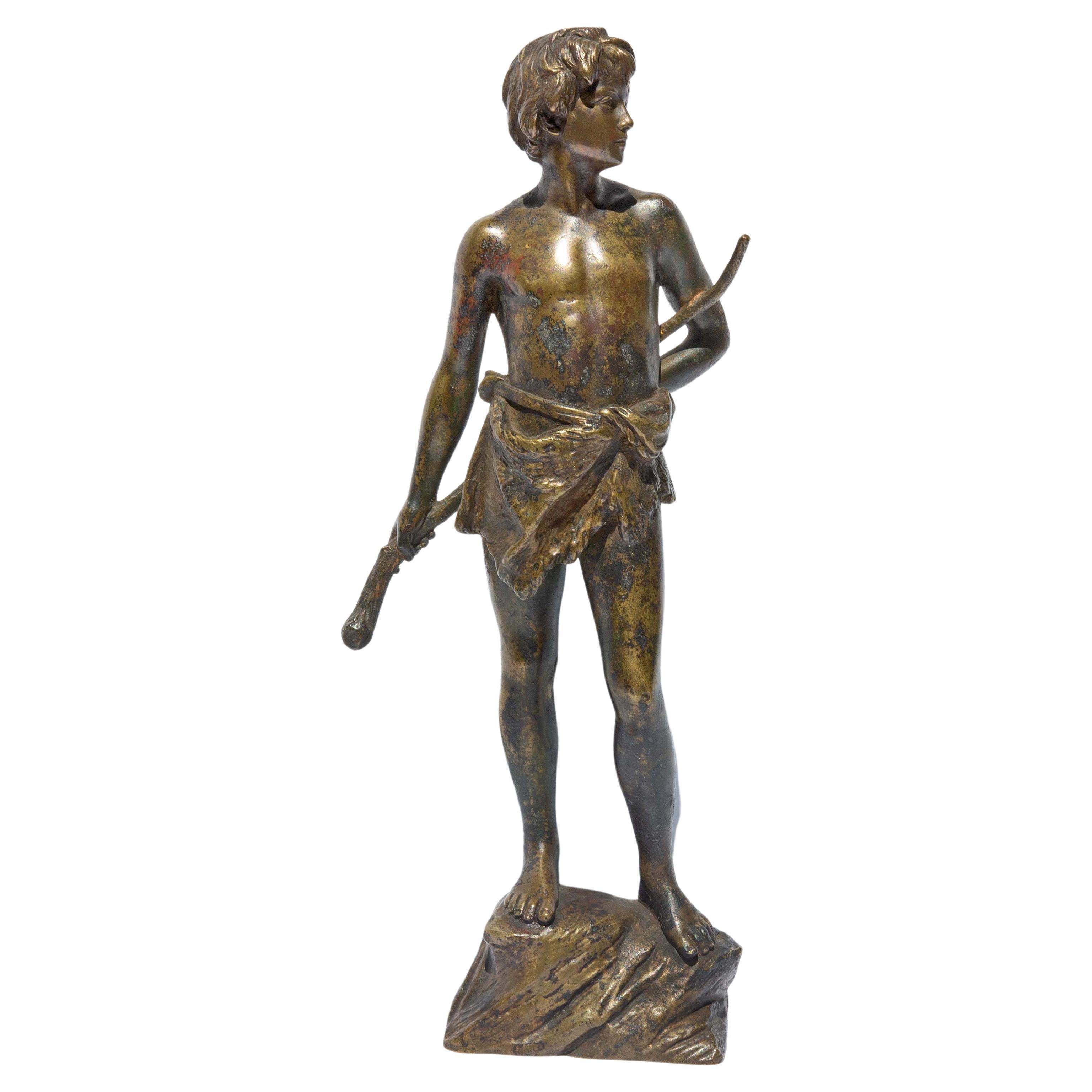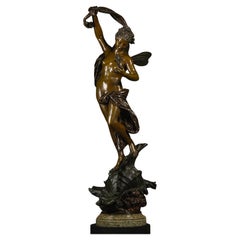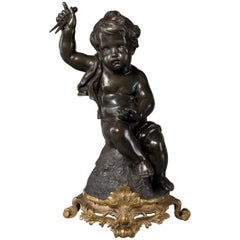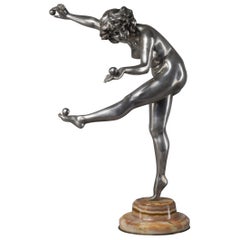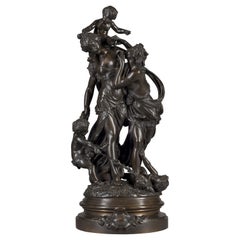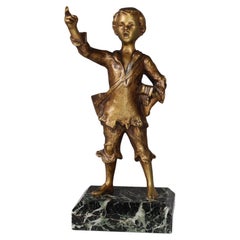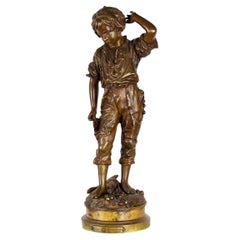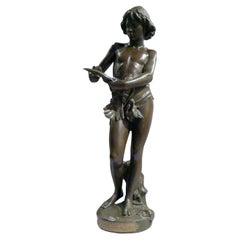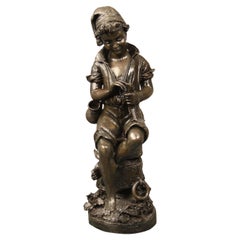Items Similar to A Patinated Bronze Figure Of 'Peter Pan', By Sir George James Frampton
Want more images or videos?
Request additional images or videos from the seller
1 of 13
A Patinated Bronze Figure Of 'Peter Pan', By Sir George James Frampton
$89,186.75
£65,000
€76,575.74
CA$122,680.83
A$136,663.70
CHF 72,087.95
MX$1,657,089.74
NOK 917,062.72
SEK 854,302
DKK 571,820.82
About the Item
Sir George James Frampton (British, 1860-1928)
A Patinated Bronze Statue Of Peter Pan
Depicted playing the pipes and conducting with his right hand. Standing on a naturalistically cast base.
Signed 'G F' in a monogram and 'P P' in a roundel. Dated 1913.
England, Dated 1913.
Provenance:
Gerald Rufus Isaacs, 2nd Marquess of Reading (1889 –1960) and Eva Violet Mond Isaacs, Second Marchioness of Reading (1895–1973).
Thence by descent until sold in 1996.
The present charming statuette of Peter Pan, dated 1913, is an exceptionally fine and early reduction of the life-size bronze exhibited by Frampton at the Royal Academy in 1911. Barrie unveiled the statue in Kensington Gardens on 30 April 1912, without fanfare and without permission, so that it might appear to children that the fairies had put it in place overnight. He published a notice in The Times newspaper the following day, 1 May: "There is a surprise in store for the children who go to Kensington Gardens to feed the ducks in the Serpentine this morning. Down by the little bay on the south-western side of the tail of the Serpentine they will find a May-day gift by Mr J.M. Barrie, a figure of Peter Pan blowing his pipe on the stump of a tree, with fairies and mice and squirrels all around. It is the work of Sir George Frampton, and the bronze figure of the boy who would never grow up is delightfully conceived."
The statue stands at the spot where, as recounted in Barrie's Little White Bird, Peter Pan lands for his nightly visits to the Gardens and where he pipes to the spirits of the children that have played there. The figure is mounted on a rock inhabited by a host of fairies, rabbits and other woodland creatures.
The sculpture which Frampton produced took its inspiration from a series of photographs taken by Barrie in July 1906, two years after the 1904 stage play premiered in London and the same year Peter Pan in Kensington Gardens was published. These photographs feature Michael Llewelyn-Davies, who, along with his brothers, was the original inspiration for the characters. Davies can be seen wearing the costume for Peter Pan which was designed for the play by William Nicholson (who also designed the scenery), and which was to become an essential part of Peter Pan's identity. In fact, the photograph of Michael wearing the costume became the ideal image of Peter Pan in Barrie's eyes.
Frampton made six other full-size casts from the original moulds, which are to be found as far afield as Brussels, New Jersey, Toronto and Perth, Australia. The success of the statue was instant, amongst children and adults alike, and its popular appeal led Frampton to produce a bronze reduction of the main figure as an independent statue during his lifetime.
The present example, dated 1913, is one of the earliest recorded and is an especially fine lifetime cast. To avoid inferior posthumous casts which were made to deceive, the collector must observe the detail of the casting and especially the modelling of the pipes. The present example has provenance to the lifetime of the artist.
- Dimensions:Height: 18.51 in (47 cm)Width: 13 in (33 cm)Depth: 10.24 in (26 cm)
- Materials and Techniques:Bronze,Patinated
- Place of Origin:
- Period:1910-1919
- Date of Manufacture:Dated 1913
- Condition:Wear consistent with age and use.
- Seller Location:Brighton, GB
- Reference Number:Seller: B782401stDibs: LU1028044240642
About the Seller
5.0
Recognized Seller
These prestigious sellers are industry leaders and represent the highest echelon for item quality and design.
Established in 1964
1stDibs seller since 2014
58 sales on 1stDibs
Typical response time: <1 hour
Associations
The British Antique Dealers' AssociationLAPADA - The Association of Arts & Antiques Dealers
- ShippingRetrieving quote...Shipping from: Brighton, United Kingdom
- Return Policy
Authenticity Guarantee
In the unlikely event there’s an issue with an item’s authenticity, contact us within 1 year for a full refund. DetailsMoney-Back Guarantee
If your item is not as described, is damaged in transit, or does not arrive, contact us within 7 days for a full refund. Details24-Hour Cancellation
You have a 24-hour grace period in which to reconsider your purchase, with no questions asked.Vetted Professional Sellers
Our world-class sellers must adhere to strict standards for service and quality, maintaining the integrity of our listings.Price-Match Guarantee
If you find that a seller listed the same item for a lower price elsewhere, we’ll match it.Trusted Global Delivery
Our best-in-class carrier network provides specialized shipping options worldwide, including custom delivery.More From This Seller
View AllA Fine And Large Patinated Bronze Figure Of A Sea Nymph
By Luca Madrassi
Located in Brighton, West Sussex
Luca Madrassi (Italian, 1848–1916)
A Fine And Large Patinated Bronze Figure Of A Sea Nymph, Entitled ‘La Fée Des Mers’ (The Spirit Of The Seas)
The semi clad winged nymph, holding a...
Category
Antique 19th Century Italian Figurative Sculptures
Materials
Bronze
Bronze Putto Figure Emblematic of Architecture, after Clodion, circa 1890
By Claude Michel Clodion
Located in Brighton, West Sussex
A fine patinated bronze Putto figure emblematic of architecture, after Claude Michel Clodion.
French, circa 1890.
Standing at 55 cm (22 inches) tal...
Category
Antique Late 19th Century French Figurative Sculptures
Materials
Bronze
'The Juggler', an Art Deco Bronze Figure, by Claire J. R. Colinet, circa 1925
By Claire Jeanne Roberte Colinet
Located in Brighton, West Sussex
'The Juggler' - A fine Art Deco silvered bronze figure, by Claire J. R. Colinet.
French, circa 1925.
Engraved to base 'CL J.R. Colinet'.
This dramatic and large silvered b...
Category
Early 20th Century French Art Deco Figurative Sculptures
Materials
Bronze
'Bacchantes', a Fine Patinated Bronze Figural Group After Clodion, circa 1870
By Claude Michel Clodion
Located in Brighton, West Sussex
'Bacchantes', a fine patinated bronze figural group after Claude Michael Clodion, French (1738-1814).
French, circa 1870.
Signed 'Clodion' to the base and inscribed 'BACCHANTE...
Category
Antique Late 19th Century French Figurative Sculptures
Materials
Bronze
'Grand Nu Aux Feuillages', a Fine Patinated Bronzed Figural Group, circa 1900
By Alois Mayer
Located in Brighton, West Sussex
'Grand Nu Aux Feuillages', a fine patinated bronzed figural group by Alois Mayer.
German, circa 1900.
Signed 'A. Mayer'.
Alois Mayer (1855-1936) Was a German Sculptor who...
Category
Antique Late 19th Century German Figurative Sculptures
Materials
Bronze, Iron
'Bonne Année, Bonne Santé', a Bronze Figure by Adolphe Maubach, circa 1900
By Adolph Maubach
Located in Brighton, West Sussex
'Bonne Année, Bonne Santé' -A fine patinated bronze figure by Adolphe Maubach.
French, circa 1900.
Signed 'Adolphe Maurbach' and bearing a gilt-bronze title plaque 'Bonne Anné...
Category
Antique Late 19th Century French Figurative Sculptures
Materials
Bronze
You May Also Like
Antique Bronze Sculpture By Henri Godet (1863 - 1937), Paris, 1910s
By Henri Godet
Located in Greven, DE
Antique bronze sculpture on a marble base by the french sculptor Henri Godet (born in Paris March, 5th 1863 - Vincennes 1937).
Depiction of a young shoe shiner boy, "Cireur de chaussures".
He wears tattered clothes with holes and is barefoot as a poor boy used to look on the streets of the former Paris.
Under his left arm he carries several shoe cleaner...
Category
Early 20th Century French Late Victorian Figurative Sculptures
Materials
Marble, Bronze
French Bronze, Boy Sculpture, Charles Anfrie, 19th Century
By Charles Anfrie, Vrai Bronze B.D.
Located in Lisbon, PT
This 19th-century bronze sculpture titled "Un Accident" captures a moment of innocent confusion through the detailed depiction of a barefoot boy in rustic clothing, scratching his he...
Category
Antique 19th Century French Napoleon III Figurative Sculptures
Materials
Metal, Bronze
$5,638 Sale Price
20% Off
Patinated bronze sculpture of young boy trimming the wings of a dove by Gregoire
Located in London, GB
Patinated bronze sculpture of young boy trimming the wings of a dove by Gregoire. This bronze known as "Captivity" represents the clipping of wings and forceful fidelity. Beautifully...
Category
Antique 1880s Figurative Sculptures
Materials
Bronze
Late 19th Century Italian Bronze Sculpture of a Fishing Boy by Fabbrini
Located in Long Island City, NY
Late 19th Century Italian Bronze Sculpture of a Fishing Boy by Fabbrini
Depicting a young boy sitting on some rocks, holding a ...
Category
Antique Late 19th Century Italian Belle Époque Figurative Sculptures
Materials
Bronze
Spectacular Patinated Bronze SCULPTURE "The Child and the Crab" 19th Cent. VIDEO
Located in Madrid, ES
Spectacular Patinated Bronze SCULPTURE depicting "The Child and the Crab"19th century
Italy late 19th century
100 x 70cm
good conditions
Category
Antique 19th Century Italian Renaissance Figurative Sculptures
Materials
Bronze
$2,756 Sale Price
20% Off
Young Goatherder Bronze Sculpture by Oscar Gladenbeck, circa 1900
Located in Rochester, NY
Bronze statue of young goatherder by Oscar Gladenbeck. circa 1900. Signed "Oscar Gladenbeck Friedrichshagen".
# nude male Grand Tour.
Category
Early 20th Century German Figurative Sculptures
Materials
Metal, Bronze
